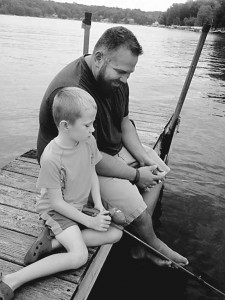A day off and nothing to do? What a luxury. But there is always something to do and that is the opportunity to take a kid fishing.
It’s been said a million times that the best and most lasting thing a parent can give his or her child is time, and time spent watching a bobber is about as good as it gets. Indeed, the smile and wide-eyed excitement shared by a youngster after landing a chunky bluegill is worth every minute of a parent’s time — and becomes a childhood memory a child will cherish forever.
How, when, and where?

Almost anytime, almost anywhere, and if the how becomes a problem start with the basics, a hook, line, and sinker, then add a child size rod and reel. You are talking about $15 at most and it’s a one-time expenditure. One hour is the right time limit. Expect most children to be attentive for about the first 15 minutes before finding some other attraction to attend to.
When my dad took me bluegill fishing I had more fun racing maggots on the seat of a rented boat or borrowed space on a boat dock than fishing. But I remember those days even now. Live bait interests most children, so do lures with shiny glitter and red beads for eyes. A good investment is a small tackle box, and every so often the purchase of a rubber worm or new bobber that can be added to his or her “tackle” adds interest in this lifetime activity.
The rules
First rule for beginners is actually for the adult, who must be sure that fish are going to bite. If there are no fish and no bites, that 15 minutes of attentiveness is going to be an eternity. Try a farm pond for starters if nothing else is readily available. The Division of Wildlife office in Akron can also provide information about youth fishing opportunities and places to fish.
Rule two is that the first fish need not be large, just hungry. Enough said.
Rule three is to keep it simple. Don’t expect a youngster to be able to cast, retrieve a lure, or do anything fancy. Use live bait, a small hook, and a bobber.
Keep it simple
Fishing is a great way to spend quality time with children but there many more ways to introduce them to learning about the outdoors.
If the ground if soft enough that animals leave prints, head outdoors to search for tracks and then identify what creature left them. Add to that a collection of track castings using plaster of Paris to make them. Or look for feathers and other signs of wildlife.
Time spent together in an outdoor activity is the opportunity to teach, to explore, and to share but most of all it’s just plain fun.












